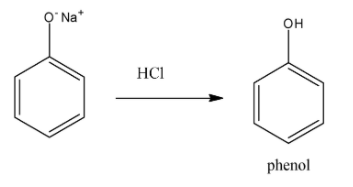Answer
324.1k+ views
Hint: We know that Dow's process is one of the ways of conversion of chlorobenzene to phenol. To obtain phenol from chlorobenzene, first we have to react with chlorobenzene with sodium hydroxide, then phenoxide ion forms. The acidification of phenoxide ions results in phenol.
Complete answer:
In Dow's process, hydrolysis of chlorobenzene results in phenol. First step is treating chlorobenzene with aqueous sodium hydroxide at a temperature of 623 K and pressure of 300 bar to convert it into sodium phenoxide.
Now, we write the reaction of formation of sodium phenoxide ion by reaction of chlorobenzene with sodium hydroxide.

The next step is the acidification of phenoxide ions. This can be done by reacting phenoxide ion with hydrochloric acid. The result of this reaction is the production of phenol.
Now, we write the reaction of production of phenol by acidification of phenoxide ions.

Hence, by Dow’s process, we are able to convert chloro benzene to phenol by Dow’s process.
Additional information:
When one hydrogen atom of the benzene ring is replaced by a hydroxide ion, then the compound is known as phenol. Phenols are commonly used as intermediates in industrial synthesis and in household products. For example, phenol is used as a disinfectant (in low concentrations) in household and mouthwash cleaners. Phenol was probably the first antiseptic surgery. Phenol is also known as carbonic acid, hydroxybenzene and phenolic acid.
Note:
Another way to convert chlorobenzene to phenol is by reacting phenol with steam at 698 K in presence of calcium phosphate. The reaction gives phenol and hydrochloric acid.

Complete answer:
In Dow's process, hydrolysis of chlorobenzene results in phenol. First step is treating chlorobenzene with aqueous sodium hydroxide at a temperature of 623 K and pressure of 300 bar to convert it into sodium phenoxide.
Now, we write the reaction of formation of sodium phenoxide ion by reaction of chlorobenzene with sodium hydroxide.

The next step is the acidification of phenoxide ions. This can be done by reacting phenoxide ion with hydrochloric acid. The result of this reaction is the production of phenol.
Now, we write the reaction of production of phenol by acidification of phenoxide ions.

Hence, by Dow’s process, we are able to convert chloro benzene to phenol by Dow’s process.
Additional information:
When one hydrogen atom of the benzene ring is replaced by a hydroxide ion, then the compound is known as phenol. Phenols are commonly used as intermediates in industrial synthesis and in household products. For example, phenol is used as a disinfectant (in low concentrations) in household and mouthwash cleaners. Phenol was probably the first antiseptic surgery. Phenol is also known as carbonic acid, hydroxybenzene and phenolic acid.
Note:
Another way to convert chlorobenzene to phenol is by reacting phenol with steam at 698 K in presence of calcium phosphate. The reaction gives phenol and hydrochloric acid.

Recently Updated Pages
If a wire of resistance R is stretched to double of class 12 physics JEE_Main

The path difference between two waves for constructive class 11 physics JEE_MAIN

What is the difference between solvation and hydra class 11 chemistry JEE_Main

IfFxdfrac1x2intlimits4xleft 4t22Ft rightdt then F4-class-12-maths-JEE_Main

Sodium chloride is purified by passing hydrogen chloride class 11 chemistry JEE_Main

Consider the following oxyanions PO43P2O62SO42MnO4CrO4S2O52S2O72 class 11 chemistry JEE_Main

Other Pages
Formula for number of images formed by two plane mirrors class 12 physics JEE_Main

Differentiate between homogeneous and heterogeneous class 12 chemistry JEE_Main

Explain the construction and working of a GeigerMuller class 12 physics JEE_Main

A currentcarrying coil is placed in a magnetic field class 12 physics JEE_Main

In the given circuit the current through the 5mH inductor class 12 physics JEE_Main

In a family each daughter has the same number of brothers class 10 maths JEE_Main



